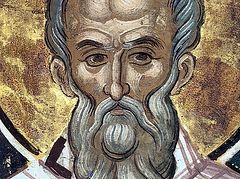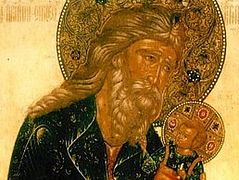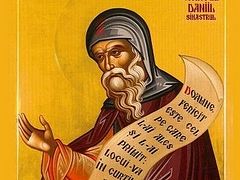 St. John the Clairvoyant of Egypt was born at the beginning of the 4th Century. He lived in the town of Lycopolis in Central Egypt, and worked as a carpenter. At tl1e age of 25, he accepted monastic tonsure. Over the course of 15 years, St. John struggled in various monasteries. Then, wanting to live in total seclusion, he left for the Hill of Wolves in the Thebaid. St. John spent 50 years in seclusion, never leaving the site of his spiritual struggle. He spoke to visitors through a little window, through which he also received the simple meals brought to him. After St. John had already spent 20 years in seclusion, God made him worthy to receive the gift of clairvoyance. Thus, he prophesied to Emperor Theodosius the Great (379 -395) that he would gain victory over his enemies Maximus and Eugenius, and that a war against the Gauls would bring him victory. To many visitors he told of events to come in their lives, and he provided them with instruction. The holy struggler would give holy oil to ill visitors who, upon anointing themselves, would be healed of their various illnesses.
St. John the Clairvoyant of Egypt was born at the beginning of the 4th Century. He lived in the town of Lycopolis in Central Egypt, and worked as a carpenter. At tl1e age of 25, he accepted monastic tonsure. Over the course of 15 years, St. John struggled in various monasteries. Then, wanting to live in total seclusion, he left for the Hill of Wolves in the Thebaid. St. John spent 50 years in seclusion, never leaving the site of his spiritual struggle. He spoke to visitors through a little window, through which he also received the simple meals brought to him. After St. John had already spent 20 years in seclusion, God made him worthy to receive the gift of clairvoyance. Thus, he prophesied to Emperor Theodosius the Great (379 -395) that he would gain victory over his enemies Maximus and Eugenius, and that a war against the Gauls would bring him victory. To many visitors he told of events to come in their lives, and he provided them with instruction. The holy struggler would give holy oil to ill visitors who, upon anointing themselves, would be healed of their various illnesses.
Venerable St. John prophesied to his hagiographer, the Monk Palladios, that he would become a bishop. The prophecy came to pass, and Palladios was made bishop of Bythinia, in Asia Minor.
In his instructions, St. John first and foremost counseled humility: “As best you can, emulate the virtuous lives of the holy fathers; even if you should succeed in accomplishing all, do not place your reliance on yourselves, do not boast about yourselves. There are many who, having achieved perfection in the virtues, became prideful, and fell from the heights into the pit. Observe meticulously: are your prayers fervent? Is the purity of your hearts undisturbed? During prayer, is your mind occupied with idle thoughts? Mark whether or not you have renounced the world with your entire soul. Do you observe others’ virtues, and at the same time take vain pride in your own? Do you take care to be a good example to others? Beware lest you have an inflated opinion of yourselves as righteous, lest you take pride in some one of your good works. Watch that during prayers, no thoughts of secular things come to mind, for there is nothing more reckless and imprudent, than to converse with God, but have your thoughts far from Him. This often takes place in those who do not so much renounce the world as they take pains to please the world. One who is thinking about many things, abandons himself to cares for the worldly and corruptible. However, having abandoned himself to worldly cares, he is already incapable of seeing God with his spiritual eyes. To one who is ever mindful of God thoughts of any manner of vanity should be foreign. To one who has achieved some measure of knowledge of God (no one attain full knowledge of God), the Mysteries of God are revealed, and he sees the future as if it were the present; like the saints, he works miracles and receives whatever he asks of God in prayer...
Children, love silence, keep your thoughts always on God, and always implore God that He might grant you a pure mind, free of sinful thoughts. Of course, also worthy of praise is the spiritual struggler who, living in the world, practices the virtues, offers hospitality to strangers, or gives alms, or helps those in need, or never rises to anger. Such a person is worthy of praise because he remains virtuous and fulfills the Lord’s commandments without abandoning his secular activities. But better and more praiseworthy will be one who, ever mindful of God, ascends from the material to the immaterial, leaving material cares and others’ concerns, himself aspires to the Heavenly. Having renounced everything earthly, and loosed from ties to the world through earthly cares, he ever stands before God. Such a person is close to God, Whom he ceaselessly praises in prayer and psalmody.
By such salvific teachings and instructive stories, and by the example of his angelic life, the Saint brought great spiritual help to others. St. John of Egypt departed to the Lord in the year 395 at the age of 90.
From Parish Life, Russian Orthodox Cathedral of St. John the Baptist, April 2019




